There are over 3,500 types of snakes on the planet and most of them know how to climb trees. Characteristics of snakes may vary, but they’re all limbless reptiles in the suborder Serpentes and are carnivores.
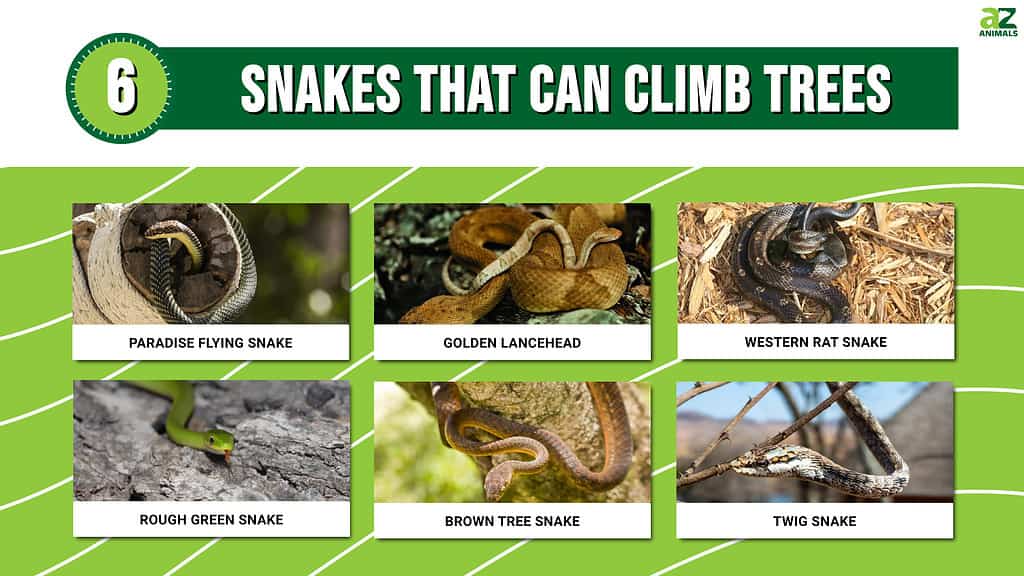
While most snakes will escape up a tree if the situation calls for it, what snake really enjoys being up in trees? What snakes are good at climbing trees? Let’s look at 6 snakes that can climb trees and why they like to do so.
Paradise Flying Snakes
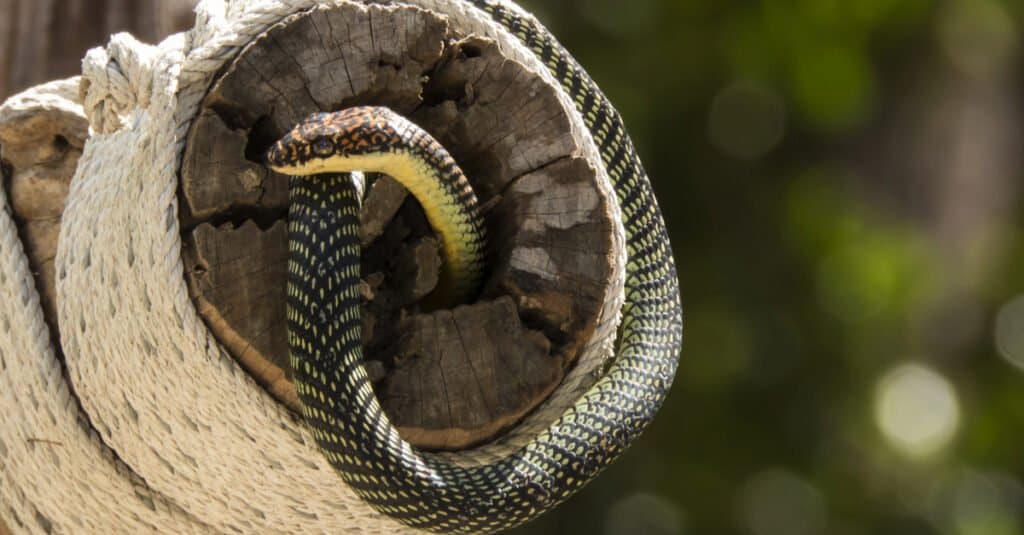
Paradise flying snakes climb well and can glide between trees.
©PACO COMO/Shutterstock.com
Paradise flying snakes flatten their body to glide between trees. They have strong abdomens which they use to launch themselves from whatever perch they’re on. Flying almost 30 feet is not uncommon for these snakes.
Paradise flying snakes are found in southeast Asia, and they’re so agile that they are considered better flyers than flying squirrels. Once the glide is happening, while mid-air they’ll undulate their flattened body so they can help steer themselves in the direction they want to go.
If they can fly high in the trees, they’re good at climbing up there.
Birds Get Golden Lanceheads to Climb Trees
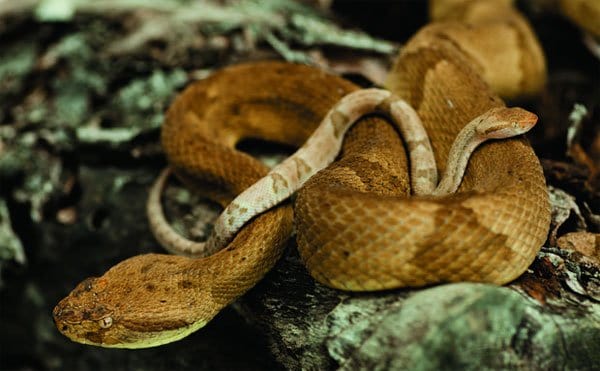
Golden lanceheads climb trees to get birds.
©Ko biet / Creative Commons – License
The golden lancehead exists on an island called Snake Island off the coast of Brazil. Snake Island is famously an isolated habitat with a lot of snakes and other animals. Snake poachers try to get to the island to score a big payday on a new and rare snake.
The golden lancehead is an extremely venomous pit viper. The fatality rate is 7% when dealing with untreated golden lancehead bites. They’re one of a few types of lanceheads, and they’re the only ones that hang out in trees part-time. They love to dine on birds, so they go up to where the birds are to sniff them out.
The golden lancehead’s venom is so potent that it will melt human tissue when envenomated, an adaptation that probably came about so they can eat birds before they get away.
Western Rat Snakes Use Their Belly Scales to Climb Trees
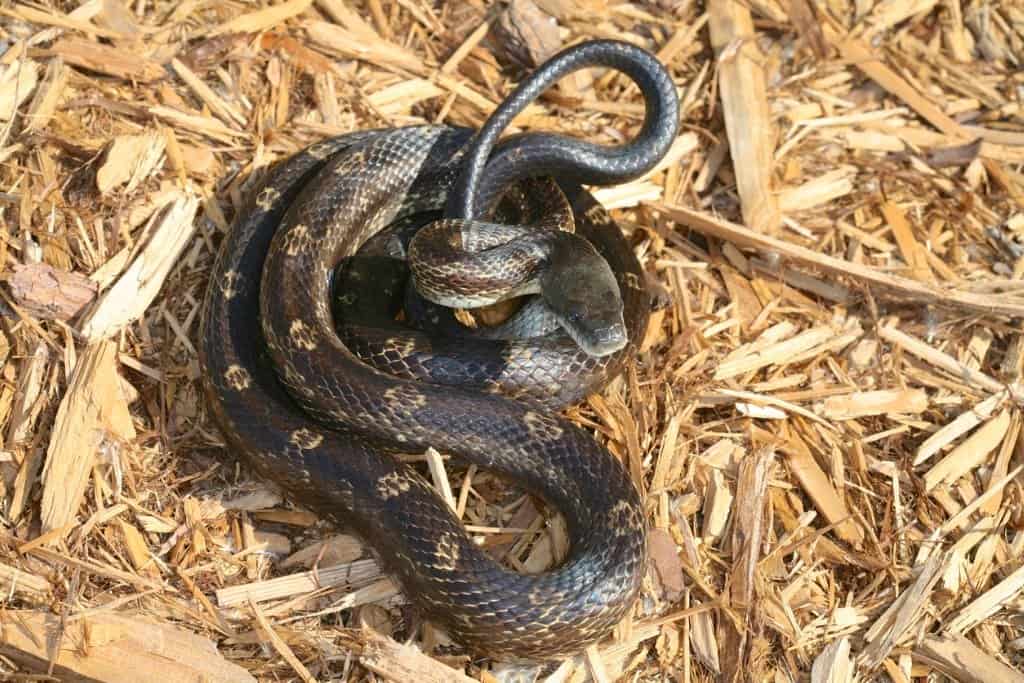
Western rat snakes climb up rough trees without using branches.
©iStock.com/Naja Shots
Western rat snakes are amazing at climbing even though the longest one on record was over 9 feet. In North America, they’re considered one of the longest snakes out there. Their belly scales come up so they can grab onto different surfaces. This allows them to shimmy up high into trees. They can only climb rough surfaces, however, because those scales need something to grasp.
Western rat snakes will even lay their eggs up in trees if there’s a good hollow. They can easily climb 20 ft high without the assistance of branches or other structures. On the ground, they spend their time in forests with a water source. They’ll also hang out in residential areas like under houses, in abandoned structures, and out in barns.
Also known as black snakes, western rat snakes are great climbers that go high up in trees in search of a meal, whether it be birds, bird eggs, lizards, rodents, or frogs. They will scavenge the ground first for all these snacks, though. They only eat about once per month, and they’re opportunistic, which means they’ll eat the easiest thing they can find.
Prey Brings the Rough Green Snake into the Trees
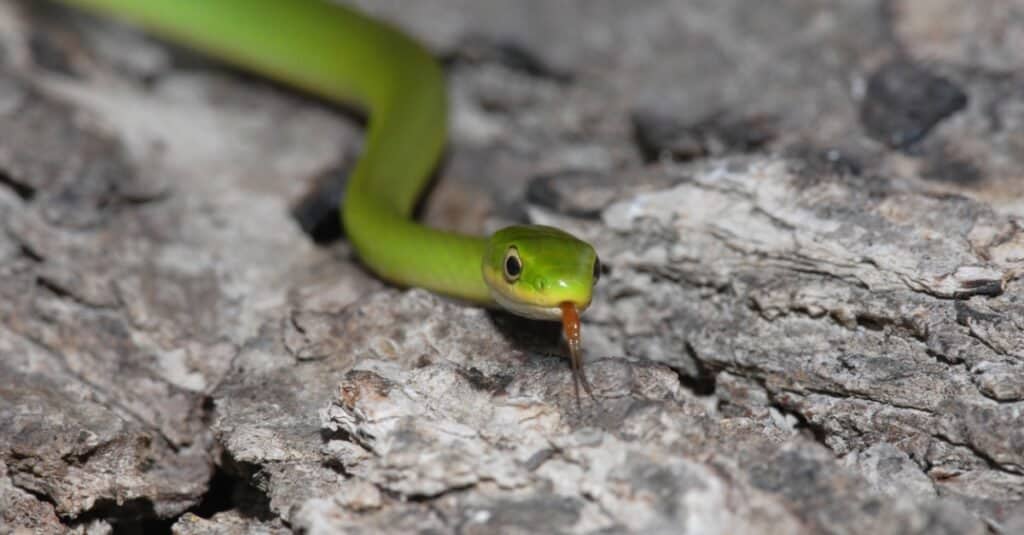
Rough green snakes like to hang from trees near a water source.
©iStock.com/Shoemcfly
Rough green snakes live predominantly in the eastern United States, and you can find them hanging from tree branches. They prefer areas with a good water source because they like to swim.
Sucking dew from leaves is a way rough green snakes are able to get their water so they can spend so much time up in trees without coming down. Insects such as crickets, caterpillars, and grasshoppers are their primary food sources. They also like to eat frogs, spiders, and snails.
The Brown Tree Snake Is a Unique Climber
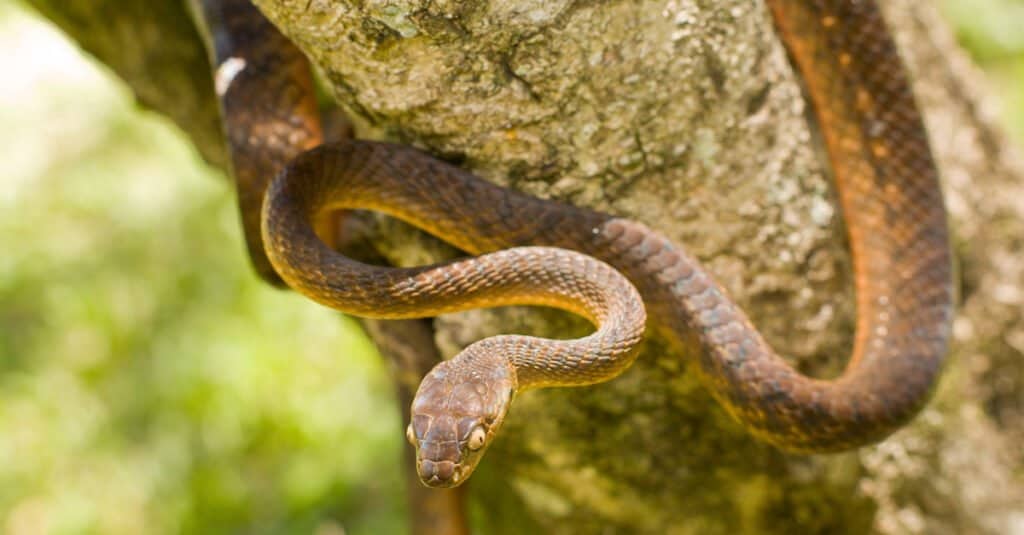
Only brown tree snakes in Guam can climb smooth trees.
©Janelle Lugge/Shutterstock.com
The Guam brown snake is unique. Using its body like a lasso, this snake winds around the tree once and slowly lifts any side of the loop to move up the tree. As an invasive species in Guam, its ability to use its body like a lasso likely contributed to the almost total destruction of native birds.
There are a lot of trees with smooth bark in the brown tree’s home range in Guam. That might explain why this behavior developed in this population. However, they’re so invasive that efforts are being made to exterminate them. Acetaminophen tablets attached to bait mice will take down a brown tree snake as they’re sensitive to the common drug.
Brown tree snakes are also found in Papua New Guinea, Indonesia, and Australia. These snakes are great climbers even if they haven’t been observed doing the lasso trick of their cousins in Guam.
Brown tree snakes are venomous, though their venom has no real effect on humans. It’s meant to kill small prey like lizards.
Twig Snakes Climb to Perch for Prey
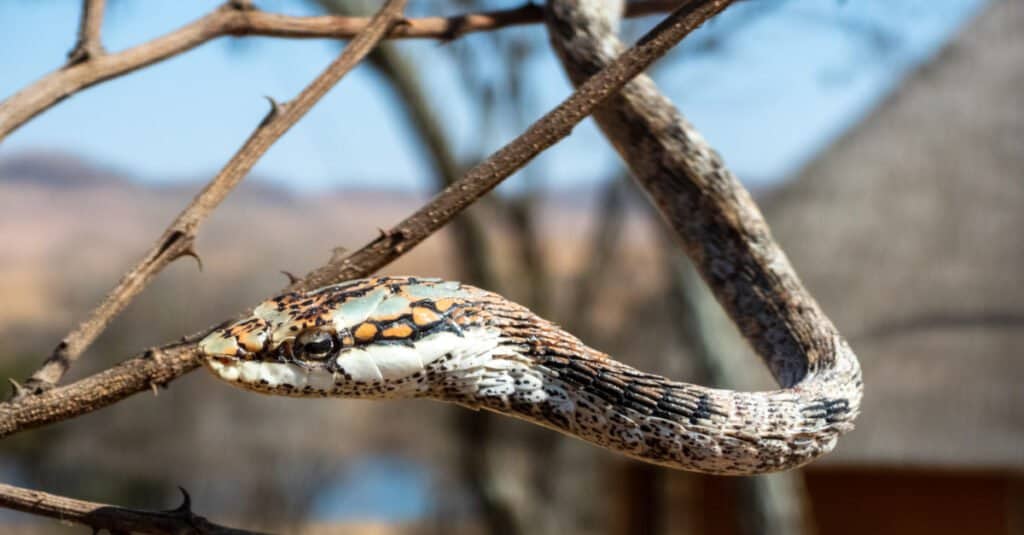
Twig snakes hide out in trees so they can ambush prey.
©Willem Van Zyl/Shutterstock.com
Twig snakes spend most of their time lounging in trees. They’re ambush predators, and they lie in wait for prey to come within striking distance by hiding amongst foliage. They usually hang out on a low-lying branch so they can eat both terrestrial and arboreal creatures.
Twig snakes are so good at hiding that they even move with the wind if a breeze is going. If they strike prey on the ground from their low-lying perch, they’re able to swallow it whole in an upward direction so they don’t have to leave their spot.
Hailing from southern Africa, twig snakes are highly venomous and have horizontal keyhole pupils capable of binocular vision. Their fangs are in the back of their mouth, and they’re non-aggressive, so bites aren’t that common. Death does occur even if the bite is treated.
The fangs in the back of this venomous snake’s mouth are much different from the back teeth common in other nonvenomous snakes like hognose snakes. That’s because these back fangs inject real toxic venom into the victim whereas the back teeth of snakes like the hognose merely pierce the victim so poisonous saliva can enter the wound.
There are a few different kinds of twig snakes throughout Africa, but they all share the same general characteristics. These snakes are also called vine snakes because they’re long and thin like a vine. That doesn’t mean they are huge; they grow up to 4 feet long.
Up Next…
Keep reading! We think you’ll like these other pages about snakes and other amazing animals.
- King Cobra vs Mongoose: Who Would Win in a Fight?
- Inland Taipan vs Brazilian Wandering Spider: Which Is More Deadly?
- King Cobra vs Lion: Who Would Win in a Fight?
- King Cobra vs Cobra: What’s the Difference?
- King Cobra vs Python: 5 Key Differences
The photo featured at the top of this post is © Rusty Dodson/Shutterstock.com
Discover the "Monster" Snake 5X Bigger than an Anaconda
Every day A-Z Animals sends out some of the most incredible facts in the world from our free newsletter. Want to discover the 10 most beautiful snakes in the world, a "snake island" where you're never more than 3 feet from danger, or a "monster" snake 5X larger than an anaconda? Then sign up right now and you'll start receiving our daily newsletter absolutely free.
Thank you for reading! Have some feedback for us? Contact the AZ Animals editorial team.






